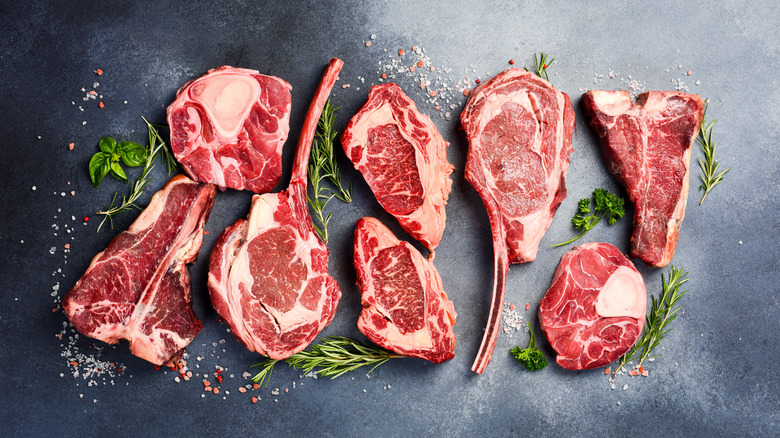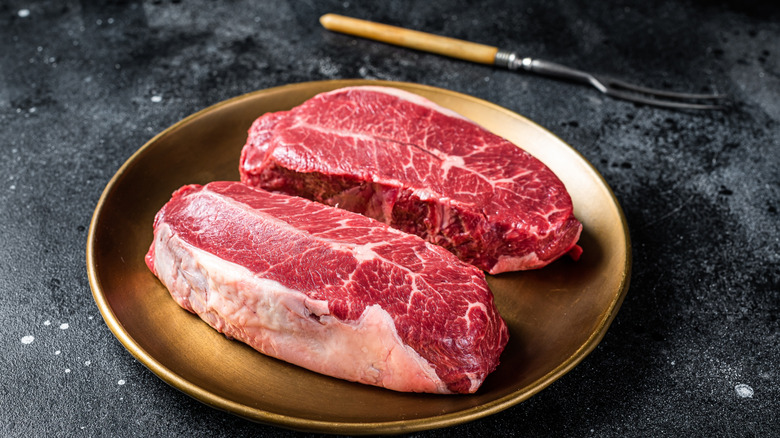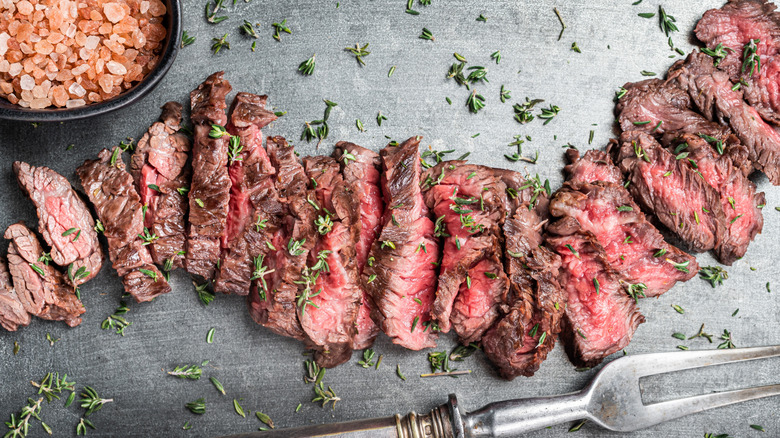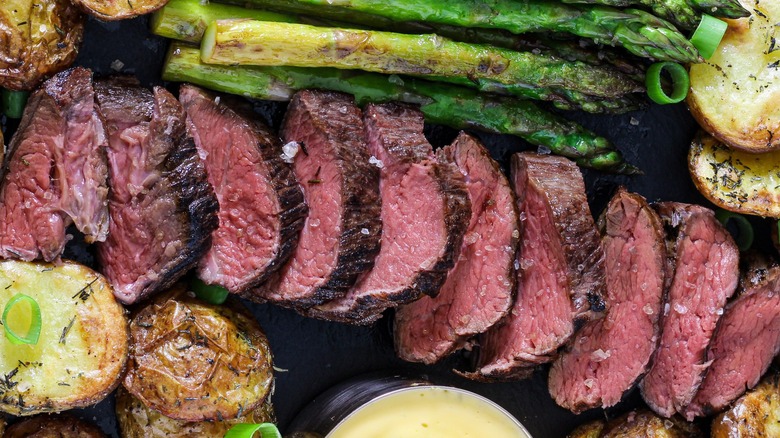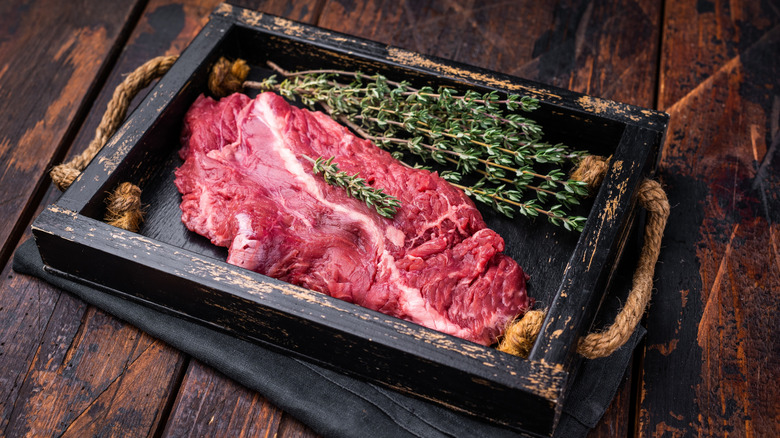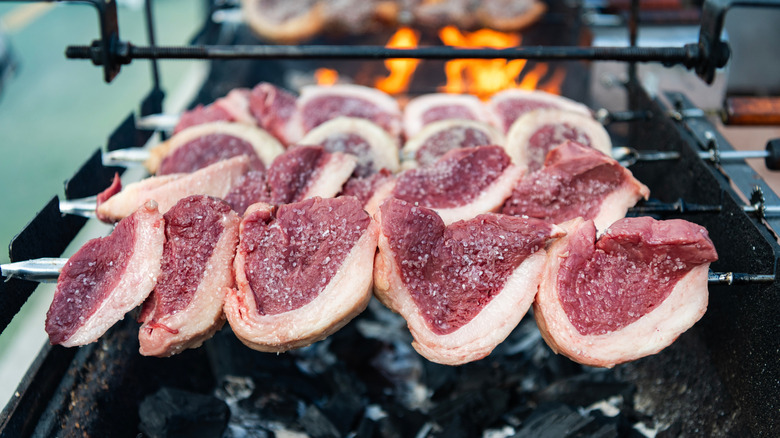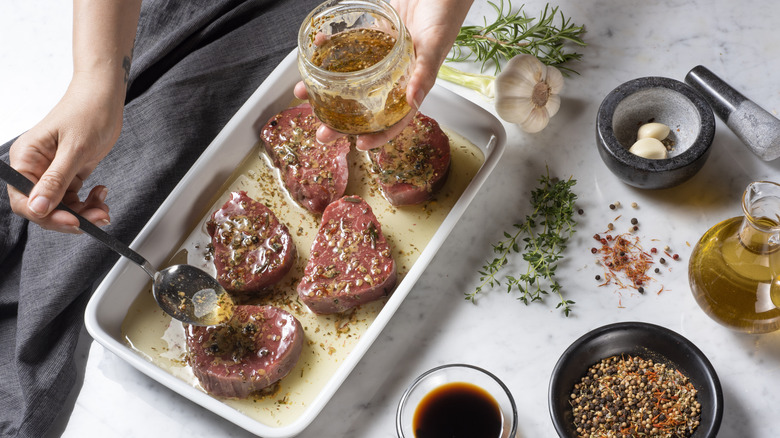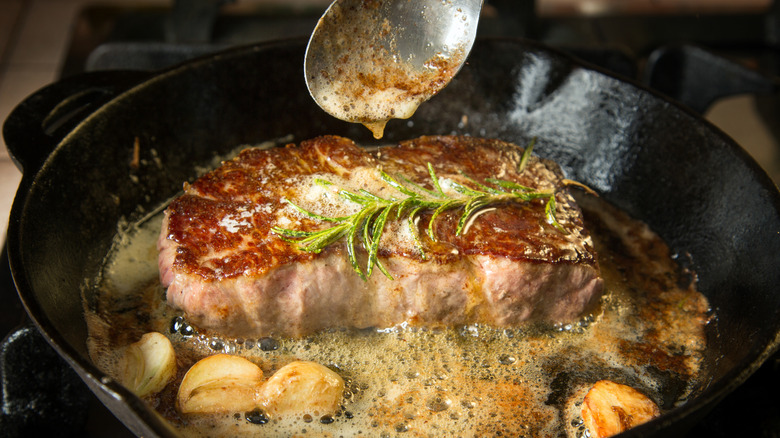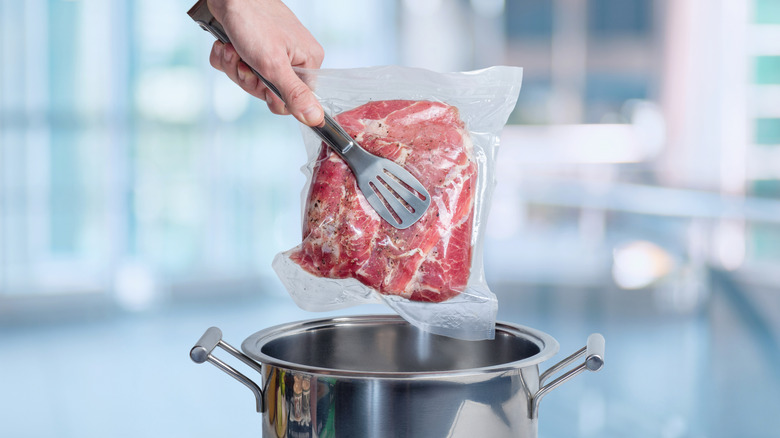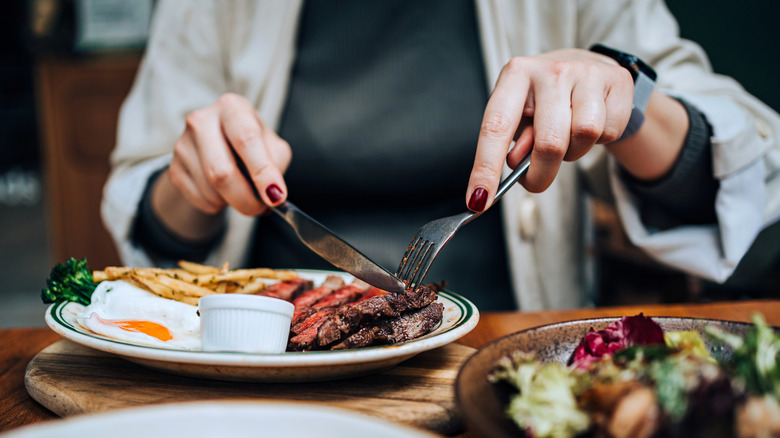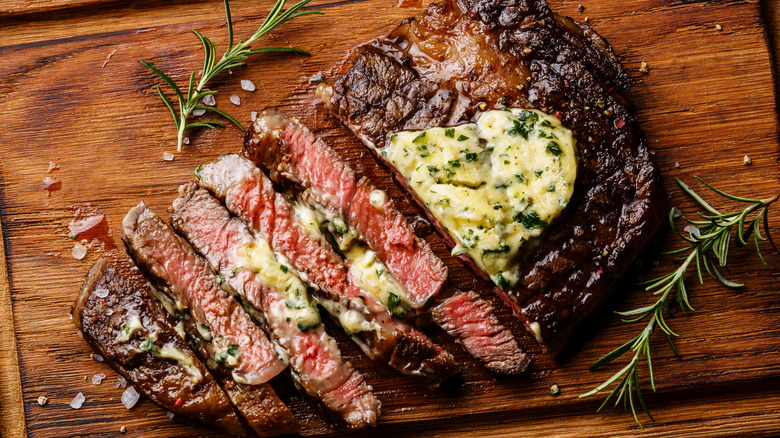The Best Cheap Steak Alternatives To High-End Cuts, According To Experts
Filet mignon, ribeye, porterhouse — mouth-watering much? These premium cuts of steak are known for their superior tenderness, beautiful marbling, and supreme flavor. But they also come with a hefty price tag.
Thankfully, and according to industry experts, you don't need to break the bank to enjoy a steak that's juicy, flavorful, and totally satisfying. With the right cut (and knowledge of what to do with it), affordable steaks can rival the more well-known heavy hitters.
To find out which budget-friendly cuts are worth throwing on the grill (and how to cook them like a pro), we spoke with two experts in the world of steak: Justin Owens, owner of the luxury beef company Manzo Piedmontese, and chef Kylian Goussot of Miami's Lafayette Steakhouse. Both shared their go-to inexpensive steak cuts and the cooking techniques that can turn them into a delicious steak dinner.
Flat iron is a delicious budget-friendly option
Certain cuts of meat are naturally tougher than others. The reason? Muscle. The more a muscle works, the more connective tissue it develops. And more connective tissues equals tougher meat. That's why the famously expensive, ultra tender filet mignon (which comes from the little-used beef tenderloin) boasts such a buttery texture. Cuts that come from more active areas (like the shoulder) tend to be tougher. But there are exceptions, of course. And flat iron is one of them.
Although this cut comes from the chuck shoulder primal which has a lot of connective tissue due to the movement it endures, the flat iron cut is specifically taken from the top muscle blade. While the top muscle blade already has less connective tissue than the rest of the shoulder, what remains is removed by a butcher. Talk about precision. The result is a surprisingly tender budget-friendly cut with beautiful marbling and a bold, beefy flavor.
Justin Owens of Manzo Piedmontese calls flat iron his go-to cut on a budget, noting that it "cooks fast," is incredibly juicy, and "has lots of flavor." Chef Kylian Goussot of Lafayette Steakhouse agrees, adding that, "when cooked properly," the cut delivers "excellent flavor and impressive tenderness."
But make sure to take Goussot's note about proper cooking seriously. Since it's a thinner cut, you'll want to quickly grill or pan-sear for best results.
Thinner cuts like skirt or flank skirt can be smart swaps if you cook them right
While thick, juicy cuts like sirloin and tenderloin often steal the spotlight, thinner steaks can be smart and delicious swaps — if you treat them right, that is. Known for their quick cooking time, both flank and skirt steak are taken from the cow's side. Skirt steak is cut from the plate primal, while flank steak comes from the neighboring flank primal.
But swapping these cuts in for pricier cuts like sirloin or tenderloin isn't without its challenges. As Justin Owens of Manzo Piedmontese explains, "This is a tricky trade-off. It's switching out thicker cuts for thin cuts." He recommends being wary with leaner cuts, adding that, "While they can have a high water content, they don't have fat that lubricates the meat during the cooking process." In other words, these cuts are far less forgiving if you aren't an A+ grill master, making it easier to overcook them if you're not paying close attention.
Chef Kylian Goussot agrees, noting that "quick, high-heat cooking methods like grilling or searing" are essential to allow these cuts to be at their best. He also recommends a good marinade and slicing meat against the grain post-cooking (and yes — there is in fact a proper way to cut skirt steak) to maximize flavor and tenderness.
Teres major may be the hidden gem of affordable steak cuts
If you've never heard of teres major (also commonly called the petite tender), you're not alone. This cut isn't widely sold — largely because it's difficult and time-consuming to extract. Although you probably won't find it pre-packaged at your local supermarket, a full-fledged butcher shop may carry the cut. And if you do track it down, it'll likely be worth it. This small but mighty cut just might be one of the most tender steaks you've never tried.
Like the flat iron, the teres major also comes from the shoulder, specifically the teres major muscle which is located a bit below the muscle flat iron is derived from. Despite coming from the chuck primal (an area typically known for its tough meat), the teres major manages to stay exceptionally soft. In fact, it's so naturally tender that it's even been compared to filet mignon. Guess they don't call it the petite "tender" for nothing.
Justin Owens of Manzo Piedmontese considers the teres major to be among his top three picks for affordable yet high-quality cuts that value flavor and tenderness. "All three are experiencing a bit of a renaissance in popularity at the moment, so they should be more readily available," he says of his recommendations, which also include picanha and chuck tender. Chef Kylian Goussot, Lafayette Steakhouse, echoes the sentiment, calling the cut an excellent choice that'll be sure to satisfy your steakhouse cravings.
Hanger steak is always delicious and sometimes affordable
Another underrated steak cut is hanger steak. While the cut is beloved in France, historically, it hasn't had the same popularity in the United States. Although it was initially known as a "butcher's steak" (since customers didn't know to ask for it and butchers would end up taking it home themselves), times are changing and the hanger steak is now gaining more recognition.
The cut is derived from the diaphragm and lands somewhere in the middle on the texture scale from ultra tender to super rough. If melt-in-your-mouth steak doesn't quite do it for you, this cut might be your match.
Both steak pro Justin Owens and chef Kylian Goussot agree that hanger steak boasts a bold beefy flavor. But hanger steak is a bit of a paradox in today's roundup as it's considered affordable yet exclusive. "It's truly amazing to me that hanger steak is considered affordable, when only two of these are produced from each animal," Owens notes. That scarcity in supply means that pricing can vary. Sometimes you may catch a great deal and other times ... not so much.
Still, if you can find hanger steak at a reasonable price, it's worth grabbing. Even the late Anthony Bourdain thought this steak cut was totally underrated. And if a steak cut can earn a Bourdain stamp of approval, it's definitely worth a try.
Picanha is a lesser known recommended option
Like hanger steak, this next cut is more popular abroad than in the United States. But instead of Europe, we're going down south — to South America, that is.
In Brazil, picanha is the star of the grilling show. But what exactly is picanha? Also known as top sirloin cap or coulotte, the cut comes from the rump area, specifically right above the cow's leg. It happens to sit next to what is perhaps a more familiar favorite: tri-tip — another budget cut Kylian Goussot and Justin Owens recommend.
Unlike many of the leaner cuts featured in today's roundup, picanha is known for its fat cap, which allows the steak to be juicy and full of flavor. Owens and Goussot agree, pointing to this cut as a great pick for those valuing rich flavor.
So if you spot picanha the next time you're shopping for steaks, you might want to grab it. It could be your last chance to get in on Brazil's best kept steak secret before the rest of the U.S. catches on.
Marinades can transform cheaper cuts of steak
Now, let's take a deeper dive into how exactly these affordable steak cuts can be elevated. If there's one thing Justin Owens, owner of the luxury beef company Manzo Piedmontese, and chef Kylian Goussot of Miami's Lafayette Steakhouse, can agree on, it's this: Never underestimate the power of a good marinade. Especially when working with a budget cut of steak. According to Owens, "Marinades can help break down connective tissue," turning tougher cuts into something much more tender.
As for the perfect marinade? Well, that's up to personal preference. Goussot recommends a mixture of "mild acids (like balsamic vinegar, citrus juice, or yogurt), fresh herbs, garlic, and spices." Owens keeps it simple, opting for olive oil, salt, and pepper.
Whether you use a heavier hand while seasoning or not, patience is key. Goussot claims that giving the meat a bit of rest time before cooking really deepens those flavors. Sure, a marinade won't turn a flank into a filet, but it can make a budget-friendly steak taste way fancier than it is. And that sounds like a win.
Match the cooking method to the cut
Picking your cut of steak is only half the battle. Once you've selected one, the fate of your dinner lies in how you cook it. And sometimes (especially with cuts on the more affordable side), the cooking method you opt for can make or break the final result.
Both experts emphasize the importance of knowing your cuts and cooking them accordingly. Chef Kylian Goussot recommends fast, high-heat methods like grilling or pan-searing for more tender cuts like flat iron, bavette, hanger, and skirt steak. These thinner cuts often respond well to minimal cooking time.
Tougher cuts like chuck, brisket, shin, or short ribs require a cook with a bit more patience. Chef Goussot recommends low and slow. Cuts full of collagen require a longer, slower, and more moist cooking process to break them down. Braising and stewing works best in these cases. In short: Cook with the right technique or pay the price (for another steak to start all over again, that is).
Sous vide can also elevate inexpensive steak cuts
Before you fire up the grill, you may want to try another steak cooking technique: sous vide. While it may sound like something reserved for a fine dining kitchen, it's one of the easiest ways to elevate an affordable cut of steak.
Sous vide, which is French for "under vacuum," involves vacuum sealing food in a bag and placing it in a temperature-controlled pot of water to cook. According to Justin Owens of Manzo Piedmontese, "Sous vide is great for getting precise temps." Once your steak reaches the perfect internal temperature — whether that's a pink-centered medium rare or a nice brown well done (we're not judging) — just give it a quick "sear in a piping hot pan for 30 seconds each side," Owens recommends.
The result? A steak that's nice and tender on the inside with a crispy crust on the outside. Sounds pretty perfect. And chef Kylian Goussot agrees, stating that cooking techniques like sous vide can "transform tougher cuts into tender, flavorful dishes."
But be careful. One of the biggest mistakes you can make when cooking sous vide is a lack of specificity. Precise cooking times and temperatures are key to achieving the perfect steak.
Be careful not to sabotage a good cut with rookie mistakes
So, you've picked a good cut. You've chosen the right cooking method. You should be all set to make a steakhouse-worthy dinner, right? Not quite. Even the best cuts of steak can fall flat due to unintentional missteps. And both Justin Owens and chef Kylian Goussot made sure to let us know what common mistakes steak-cooking novices may want to watch out for.
According to Goussot, Lafayette Steakhouse, a frequent mistake is overcooking and, in turn, drying out your meat. But, have no fear, Goussot believes that knowing which cooking methods align with which cuts can help those of us at home avoid such a mistake.
But Owens, Manzo Piedmontese, takes it one step further, emphasizing the importance of getting familiar with the makeup of the cut itself. "Understanding the connective tissue, muscle grain direction," and "taking time to remove silverskin or tendons will help." Now, you don't have to become a DIY butcher, but knowing where your steak is coming from and how it is structured can go a long way. A quick Google search should do the trick.
Another mistake? Skipping the rest period after cooking. Are you thinking: Seriously, there's a resting period both before and after cooking my steak? The short answer: Yes, there is. Chef Goussot recommends a steak resting period of 5-10 minutes, claiming that it "allows the juices to redistribute, keeping it moist and flavorful." Although your stomach may be rumbling, it's likely your patience will be rewarded via a delicious steak dinner.
The right cut may change based on the cattle
If it wasn't clear already, steak cuts vary. A lot. But, sometimes, how a certain cut behaves has less to do with where it comes from on the cow and more to do with which cow it comes from.
As the owner of Manzo Piedmontese, Justin Owens knows a thing or two about cattle. He points to Fassone — an Italian cattle breed — as something that defies expectations. "Fassone is interesting in that it truly breaks the mould," he says. "We've had chefs use brisket for tartare, top round for sushi, coulotte for tonkatsu, bavette for nigiri, bottom round for sashimi, and eye of round for carpaccio." Utilizing these cuts in raw dishes is pretty rare — literally.
The secret? Breed. Owens argues that the "right" cut for a specific dish is often dependent upon the cattle being used. He even goes as far as to say that Manzo Piedmontese's toughest cut of Fassone beef outperforms USDA Prime ribeye when it comes to tenderness — a good reminder that which cuts are labeled tough vs. tender is relative.

